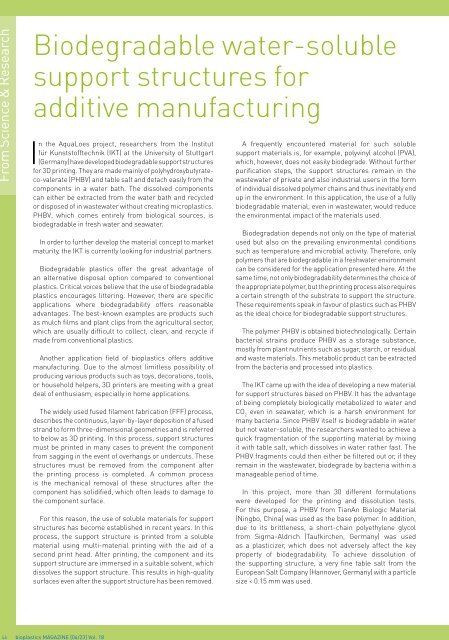Issue 04/2023
Highlights 100th issue Rebranding
Highlights
100th issue
Rebranding
You also want an ePaper? Increase the reach of your titles
YUMPU automatically turns print PDFs into web optimized ePapers that Google loves.
46 bioplastics MAGAZINE [<strong>04</strong>/23] Vol. 18<br />
From Science & Research<br />
Biodegradable water-soluble<br />
support structures for<br />
additive manufacturing<br />
In the AquaLoes project, researchers from the Institut<br />
für Kunststofftechnik (IKT) at the University of Stuttgart<br />
(Germany) have developed biodegradable support structures<br />
for 3D printing. They are made mainly of polyhydroxybutyrateco-valerate<br />
(PHBV) and table salt and detach easily from the<br />
components in a water bath. The dissolved components<br />
can either be extracted from the water bath and recycled<br />
or disposed of in wastewater without creating microplastics.<br />
PHBV, which comes entirely from biological sources, is<br />
biodegradable in fresh water and seawater.<br />
In order to further develop the material concept to market<br />
maturity, the IKT is currently looking for industrial partners.<br />
Biodegradable plastics offer the great advantage of<br />
an alternative disposal option compared to conventional<br />
plastics. Critical voices believe that the use of biodegradable<br />
plastics encourages littering. However, there are specific<br />
applications where biodegradability offers reasonable<br />
advantages. The best-known examples are products such<br />
as mulch films and plant clips from the agricultural sector,<br />
which are usually difficult to collect, clean, and recycle if<br />
made from conventional plastics.<br />
Another application field of bioplastics offers additive<br />
manufacturing. Due to the almost limitless possibility of<br />
producing various products such as toys, decorations, tools,<br />
or household helpers, 3D printers are meeting with a great<br />
deal of enthusiasm, especially in home applications.<br />
The widely used fused filament fabrication (FFF) process,<br />
describes the continuous, layer-by-layer deposition of a fused<br />
strand to form three-dimensional geometries and is referred<br />
to below as 3D printing. In this process, support structures<br />
must be printed in many cases to prevent the component<br />
from sagging in the event of overhangs or undercuts. These<br />
structures must be removed from the component after<br />
the printing process is completed. A common process<br />
is the mechanical removal of these structures after the<br />
component has solidified, which often leads to damage to<br />
the component surface.<br />
For this reason, the use of soluble materials for support<br />
structures has become established in recent years. In this<br />
process, the support structure is printed from a soluble<br />
material using multi-material printing with the aid of a<br />
second print head. After printing, the component and its<br />
support structure are immersed in a suitable solvent, which<br />
dissolves the support structure. This results in high-quality<br />
surfaces even after the support structure has been removed.<br />
A frequently encountered material for such soluble<br />
support materials is, for example, polyvinyl alcohol (PVA),<br />
which, however, does not easily biodegrade. Without further<br />
purification steps, the support structures remain in the<br />
wastewater of private and also industrial users in the form<br />
of individual dissolved polymer chains and thus inevitably end<br />
up in the environment. In this application, the use of a fully<br />
biodegradable material, even in wastewater, would reduce<br />
the environmental impact of the materials used.<br />
Biodegradation depends not only on the type of material<br />
used but also on the prevailing environmental conditions<br />
such as temperature and microbial activity. Therefore, only<br />
polymers that are biodegradable in a freshwater environment<br />
can be considered for the application presented here. At the<br />
same time, not only biodegradability determines the choice of<br />
the appropriate polymer, but the printing process also requires<br />
a certain strength of the substrate to support the structure.<br />
These requirements speak in favour of plastics such as PHBV<br />
as the ideal choice for biodegradable support structures.<br />
The polymer PHBV is obtained biotechnologically. Certain<br />
bacterial strains produce PHBV as a storage substance,<br />
mostly from plant nutrients such as sugar, starch, or residual<br />
and waste materials. This metabolic product can be extracted<br />
from the bacteria and processed into plastics.<br />
The IKT came up with the idea of developing a new material<br />
for support structures based on PHBV. It has the advantage<br />
of being completely biologically metabolized to water and<br />
CO 2<br />
even in seawater, which is a harsh environment for<br />
many bacteria. Since PHBV itself is biodegradable in water<br />
but not water-soluble, the researchers wanted to achieve a<br />
quick fragmentation of the supporting material by mixing<br />
it with table salt, which dissolves in water rather fast. The<br />
PHBV fragments could then either be filtered out or, if they<br />
remain in the wastewater, biodegrade by bacteria within a<br />
manageable period of time.<br />
In this project, more than 30 different formulations<br />
were developed for the printing and dissolution tests.<br />
For this purpose, a PHBV from TianAn Biologic Material<br />
(Ningbo, China) was used as the base polymer. In addition,<br />
due to its brittleness, a short-chain polyethylene glycol<br />
from Sigma-Aldrich (Taufkirchen, Germany) was used<br />
as a plasticizer, which does not adversely affect the key<br />
property of biodegradability. To achieve dissolution of<br />
the supporting structure, a very fine table salt from the<br />
European Salt Company (Hannover, Germany) with a particle<br />
size < 0.15 mm was used.

















